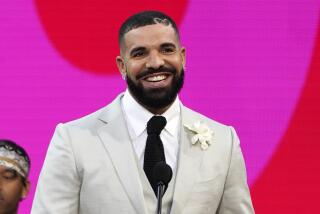Old-school? Her?
CHRISTINA AGUILERA wants to be a revivalist.
She’s titled the already much-fussed-over album that hits stores today “Back to Basics.” Its complementary discs of hip-hop and high-concept pop have been packaged in a retro sleeve emblazoned with the phrase “a ‘new orthophonic’ hi fidelity recording” -- as if the laser-etched plastic contained within could be played on a phonograph from the 1920s.
To promote her first single, the horn-maddened “Ain’t No Other Man,” the singer made a video in which she evokes pop’s favorite Betties -- Boop, Grable and Page -- while wearing enough sequins to make Elizabeth Taylor squint. She’s planning a fall tour of jazz clubs under the equally retro moniker Baby Jane and has been telling the media that (a song called “Still Dirrty” and a crush on Halle Berry aside) old-fashioned wedded bliss to music exec Jordan Bratman has allowed her to trust herself enough to make music that links her to the past she so romanticizes.
As if these extra-musical signals weren’t enough, Aguilera makes her orientation explicit in the song “Back in the Day,” which promotes the old idea that truly original music was created before hip-hop. “Open your mind, enjoy the ride,” Aguilera sings as a roll call of heroes unspools behind her: Lena Horne, Aretha Franklin, Minnie Riperton, Otis Redding, Gladys Knight, Stevie Wonder. Though “Back in the Day” itself sounds like none of those artists, it leaves no doubt that Aguilera’s never letting them stray far from her mind.
Take another look at that list. Every name belongs to an African American: This is another way in which Aguilera, born of an Irish American mom and Ecuadorean dad, seems to be falling in line with the pop revivalist program. Artists who present themselves as “old school” to assert their integrity generally prefer the “pure” legacies of black jazz, blues and soul to the more muddled realities of historical mainstream pop, in which Bing Crosby reinvented singing by borrowing from Louis Armstrong, and Ray Charles bucked the system by recording a country album in 1962.
As a leading voice in a generation for whom racial divides matter less than ever before -- in terms of musical preferences, at least -- it’s natural for Aguilera to claim the same spiritual mentors as a peer such as Alicia Keys would. But the specificity of her inspiration oddly implies that the hallowed past she wishes to reenter might have no room for an interloper such as herself.
Too much too soon
The aura of purity that surrounds “Back to Basics” comes in response to something specific. Aguilera’s last album, 2003’s adventurous “Stripped,” pushed the singer toward a rock-soul hybrid sound not unlike the one pioneered by LaBelle, a group she doesn’t name check on “Back to Basics,” though in her previous incarnation she covered the band’s most famous song, “Lady Marmalade.”
“Stripped” was a brave move, crackling with anthems about female solidarity and sexual liberation and confessions of Aguilera’s own childhood experiences of abuse. But it was too much too soon -- though legally an adult at 22, the Aguilera of “Stripped” was only just emerging from the cocoon of Disney-friendly teen pop, and her public just wasn’t ready for her multiple piercings and lyrics about sweating until her clothes came off.
The vintage surfaces of “Back to Basics” present a much prettier image, one that girds against Aguilera’s natural excesses -- the album does include a song that samples the voices of fans telling her she’s given them a reason to live -- by mining the natural elegance of traditionalism.
There’s one hitch, though. The music on “Back to Basics” doesn’t sound retro at all -- certainly not in the pencil-skirt, processed-hair, Golden Oldies sense. The first disc, made largely under the guidance of venerable hip-hop DJ Premier, puts Aguilera’s voice in dialogue with musical elements that complement her intense singing style -- rampaging horns, snare drums, vocal samples that recall the church and the juke joint.
Connecting to history in ways more cyborg than preservationist, expressing the thoughts of a woman whose idea of old-fashioned incorporates kinky eroticism and total independence, this club-friendly set allows Aguilera to explore pop’s past with the fresh attitude of a child who is sorting through photo albums she has found in her parents’ drawer.
Several of hip-hop’s top producers follow Premier’s collagist lead on their own tracks. Kwame’s hot and humid “Understand” creates a duet between Aguilera and 1960s Louisiana soul queen Betty Harris by sampling the haunting, Allen Toussaint tune “Nearer to You.”
On “Makes Me Wanna Pray,” Rich Harrison stages a musical double-dutch contest between Aguilera, a hopped-up choir and classic-rock keyboardist Steve Winwood. And hipster DJ Mark Ronson uses flamenco guitar and a fluttery vocal arrangement to dress Aguilera’s coo in 1970s chiffon in the honey-sweet “Without You.”
Aguilera and her producers don’t attempt to re-create an era the way actual revivalists do. Their obvious reference points are more contemporary: En Vogue, Premier’s group Gang Starr and Kanye West. (One producer not quoted is Scott Storch, Aguilera’s former writing partner, who appears to be the target of a scathing and acronymically obscene farewell track.) Like other young history buffs, Aguilera uses her reference points in the service of her own sensibility, which is emotionally direct rather than formally focused -- hot, not cool.
Part two of “Back to Basics” is more insular. This song suite, produced by Linda Perry (whose empowerment anthem “Beautiful” was the hit that saved “Stripped” from unmitigated disaster), constitutes a real concept album, or maybe the basis for the off-Broadway revue that Aguilera has yet to mount. Starting with an ornate if rather silly circus fanfare (with Perry in barker mode, promising a show that will reveal the truth “behind the faces full of paint”), its 32 minutes of music takes Aguilera through musical history while allowing her to remain her completely contemporary self.
After the reverb-heavy “Welcome,” which brings to mind “Hedwig and the Angry Inch,” Aguilera dips back in time on songs that take on particular styles, from Andrews Sisters swing (to which she adds some witty smut) to an eerily Plasticine re-creation of Bessie Smith’s blues, to a Mae West-style number that replaces that great Dirty Blonde’s balance of distance and raunch with a shamelessness more suitable for these NC-17 times.
Amid all this genre hopping, Aguilera touches home base with her favorite mode of self-expression -- the genre-crossing blockbuster ballad. It’s on these less retro songs that Aguilera connects to the forebear most like herself, one whose name is never mentioned on “Back to Basics”: Barbra Streisand.
Though Aguilera hold blues and jazz dear, it’s Streisand, that singular pop presence, whom she might do best to emulate. Emerging in a very different moment than Streisand did, Aguilera is right to claim her favorite black singers as mother figures; the racial divide that Streisand represented in some ways was false then and seems ridiculous now. And Aguilera can sing in a blues or jazz style; her voice is as purely powerful as that of her beloved Etta James, and with work, she’s moving toward the expressiveness of Gladys Knight, if not Aretha Franklin.
But Aguilera doesn’t naturally possess James’ sense of raucous fun or the ease of delivery that made those other soul singers great. Even on her up-tempo numbers, where she works in a hip-hop mode completely foreign to the concert hall, Aguilera remains studied, theatrical. If she recalls any rhythm-and-blues diva, it’s Streisand’s old duet partner Donna Summer, another former star of the musical stage who always added Broadway flair to her pop hits.
Aguilera’s Streisand-esque tendencies are a good thing; they’re helping her figure out how to become the “great singer” she’s been dubbed since she released her first single, the wise-beyond-its-years “Genie in a Bottle,” at 18.
The ‘good’ and ‘bad’
In pop, great singing is a flexible idea applicable to everyone from the monotone Johnny Cash to the octave-scaling Mariah Carey. But for mainstream female stars since pop went corporate in the 1980s, a stark divide has defined the term.
On one side is the powerhouse blandness embodied by Whitney Houston at her most overwhelmingly aggressive; on the other is the Madonna approach, in which street savvy, daring and the right collaborators matter more than vocal prowess.
Pop’s “bad” singers have all the style, while the “good” singers own all the chops. And so they have lined up: Britney and J.Lo versus Mariah and Celine, with only a few stars -- Mary J. Blige and Bjork among them -- somehow defying categorization.
Aguilera emerged in 1999 as the crown princess of the good singers, but she also obviously had brains and style. “Stripped,” with its tough statements of street feminism, was supposed to create a space for the smart Christina to emerge. It failed. This “good” singer tried to become a high-concept bad girl and found she couldn’t reconcile that stance with her gifts.
Now she’s finding herself in an approach that values chops and smarts; she’s working to develop a more subtle dramatic sense. This idea of “good” singing operates across genres and unites Streisand’s legacy with artists Aguilera does name check, like Billie Holiday and Marvin Gaye.
What’s old-fashioned about these singers’ styles isn’t a particular sound but the idea of care: Every phrase, every aside in a song must be carefully considered and well placed. Aguilera’s aiming to make that happen with the future-thinking retro moves of “Back to Basics.” The lessons she’s learned through this flirtation with revivalism will serve her well as she inevitably reasserts herself as the utterly contemporary creature she is.
More to Read
The biggest entertainment stories
Get our big stories about Hollywood, film, television, music, arts, culture and more right in your inbox as soon as they publish.
You may occasionally receive promotional content from the Los Angeles Times.






